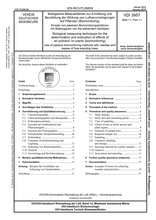Standards Worldwide
Standards Worldwide
Phone +49 30 58885700-07

Technical rule [CURRENT]
VDI 3957 Blatt 11:2019-01
Biological measuring techniques for the determination and evaluation of effects of air pollution on plants (biomonitoring) - Use of passive biomonitoring methods with needles and leaves of free-standing trees
- German title
- Biologische Messverfahren zur Ermittlung und Beurteilung der Wirkung von Luftverunreinigungen auf Pflanzen (Biomonitoring) - Einsatz von passiven Biomonitoringverfahren mit Blattorganen von frei stehenden Gehölzen
- Publication date
- 2019-01
- Original language
- German, English
- Pages
- 22
- Publication date
- 2019-01
- Original language
- German, English
- Pages
- 22
Product information on this site:
Quick delivery via download or delivery service
Buy securely with a credit card or pay upon receipt of invoice
All transactions are encrypted
Short description
The standard gives specifications for the detection of effects by passive monitoring techniques in the area of influence of emission sources. It is aimed at operators of installations, accredited experts, consulting companies, authorities, and institutions that investigate and assess the effects and spatial distribution of installation-related immissions on plants including the accumulation of substances caused by immissions. The passive biomonitoring technique described, using needles and leaves of free-standing trees and shrubs, can be deployed quickly with little effort. Hence, it can quickly produce reliable results. The standard identifies those species and plant organs preferable for optimising the significance, comparability, and assessment of results. Meaningful areas of application and use cases of passive monitoring with trees and shrubs are, in particular, environmental impact studies and procedures for securing evidence concerning immission ecology. Extensive comparative data on deciduous and coniferous trees from all over Germany can be viewed in the German Environmental Specimen Bank at the following link: https://www.umweltprobenbank.de/de/documents/investigations
Content
ICS
13.040.20
Replacement amendments
This document replaces VDI 3957 Blatt 11:2007-10 .
Also available in
Loading recommended items...
Loading recommended items...
Loading recommended items...
Loading recommended items...
